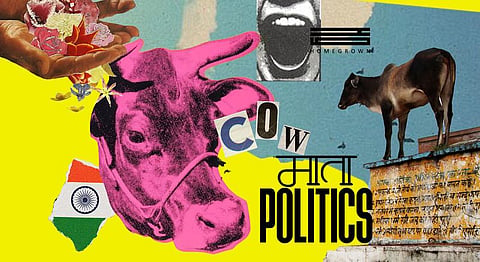
- HOMEGROWN WORLD
- #HGCREATORS
- #HGEXPLORE
- #HGVOICES
- #HGSHOP
- CAREERS
- ABOUT US
- CONTACT US

India experienced its fair share of ‘firsts’ in 2020, but the beginning of the new year seems to be bringing in more of the somewhat (to put it lightly) bizarre kind.
The sanctity of cows is a long-standing concern in India. It is not that the origination of Hinduism brought about the belief of the ‘sacred cow’ – one of India’s oldest texts, the Rig Veda (1500 BC) mentions the consumption of cow meat. Even the Brahmanas (900 BC) says that a cow or bull must be eaten when a guest arrives in one’s home.
The cow had always been considered important due to the fact that it was a holistic source of nutrition (milk and ghee to consume, and urine and dung as fertilisers). When Buddhism and Jainism began to spread its message across the country, its importance of vegetarianism began to gain more than sufficient traction. Soon, the importance of cows became somewhat entangled with the higher caste of Brahmins, and harming a cow in any way or form was considered no less than endangering the Brahmins and their beliefs. And so, it is probable that this ‘holy cow’ syndrome is rooted in our wretched caste system, and not what Hindu scriptures originally stood for.
Come 2020, we see a new height of the heavy right-wing Indian Government’s attempt to spread messages of the sanctity of cows, following their multiple moves to get rid of the consumption of its meat altogether.
Homegrown looks back at some of these very steps at a time when the message propagation in a top-down format is more rampant than ever.
Newest Addition: How Well Do You Know Your Holy Cow?
A nationwide examination titled ‘Kamdhenu Gau-Vigyan Prachar-Prasar Pareeksha’ will be held on 25 February. The Rashtriya Kamdhenu Aayog (RKA) announced the first of its kind exam that is meant to test people’s knowledge on “gau vigyan” (Cow Science).
It is not difficult to decipher that such an event should probably be the least of India’s priorities, but here we are. While the exam itself is voluntary, it is the message behind it that concerns us — does ‘Cow Science’ take precedence over a pandemic, fulfilment of our farmers’ rightful wishes and an economy desperate to stay afloat among so many more issues?
BJP’s Hot Take On ‘What Not To Eat (Ever)’
In India, where many of our actions are regularly scrutinised, there is one such activity that truly catches the eye of the government – cow slaughter. The consumption of beef is a big no-no for the Bharatiya Janata Party (BJP) owing to their deep-set belief of cows being sacred animals. Hence, a majority of the states are governed by rules and ordinances that prevent it from happening.
All states except five (Kerala, Arunachal Pradesh, Meghalaya, Mizoram & Nagaland) have a form of prohibition on slaughter of cattle and/or cows that attracts a consequence. The rampant pace of such stringent rules being put in place, regarding the consumption of the kind of meat one must or must not consume calls for introspection. Constitutionally, no basis for such laws exists. Prohibition of cow slaughter is not an enforceable fundamental right. It does exist as a Directive Principle of State Policy, which helps state legislations in policymaking, but does not hold in court.
Religious beliefs, however, were not considered during the formation of the Constitution and its constituents. Ironically, it is the only thing ruling and fuelling these anti-slaughter rules and regulations.
Who’s Up For Protection?
When the BJP came to national power in 2014, India took a steep turn in terms of the reinforcement of its beliefs. Since the anti-slaughter rhetoric was put in place, countless people (mostly Muslim, Dalits and Adivasis) have lost their lives to mob lynchings, which refers to an overly passionate group of Hindu nationalists taking the life of a human being solely based on the assumption that they were going to slaughter the animal, or were carrying its meat, or rage over the fact that they indeed were.
Does the life of a fellow Indian citizen not hold as much value as that of cattle? Or did it fall short just enough for the absolute violent rage of the vigilantes to take over? The concerned state governments did not do much, stating the possibility of it being an “accident” – an accident that repeats itself till this day.
The young Indian is going to grow up thinking that the country that boasts of harmony actually disguises it as forceful silence. Over the years, it seems as if our sensitivity has given way to polarisation in a way that feels irreversible. The ‘sacred cow’ scheme does not even cater to all beliefs – it caters to one, and only one. If 2020 left us with any lessons, it is that any valuable change takes place if we all do our part, but how do we do that if the system itself works on its own tracks and in its own time?
There are various reasons for us to refer to our country as the ‘New India’. A lot has changed but in all fairness, we cannot say it’s all for the better. Cow protection, vigilantes and lynching seamlessly became part of our vocabulary and commonly used along with words such as ‘Muslim’.
India’s religious beliefs were overpowered by religious dominance, and since then, India has never been the same.
If you enjoyed reading this, we suggest you also read:
